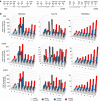ELL facilitates RNA polymerase II pause site entry and release
- PMID: 22252557
- PMCID: PMC3272570
- DOI: 10.1038/ncomms1652
ELL facilitates RNA polymerase II pause site entry and release
Abstract
Transcription is a multi-stage process that coordinates several steps within the transcription cycle including chromatin reorganization, RNA polymerase II recruitment, initiation, promoter clearance and elongation. Recent advances have identified the super elongation complex, containing the eleven-nineteen lysine-rich leukaemia (ELL) protein, as a key regulator of transcriptional elongation. Here we show that ELL has a diverse and kinetically distinct role before its assembly into the super elongation complex by stabilizing Pol II recruitment/initiation and entry into the pause site. Loss of ELL destabilizes the pre-initiation complexes and results in disruption of early elongation and promoter proximal chromatin structure before recruitment of AFF4 and other super elongation complex components. These changes result in significantly reduced transcriptional activation of rapidly induced genes. Thus, ELL has an early and essential role during rapid high-amplitude gene expression that is required for both Pol II pause site entry and release.
Figures








Similar articles
-
The Tax oncogene enhances ELL incorporation into p300 and P-TEFb containing protein complexes to activate transcription.Biochem Biophys Res Commun. 2015 Sep 11;465(1):5-11. doi: 10.1016/j.bbrc.2015.07.072. Epub 2015 Jul 17. Biochem Biophys Res Commun. 2015. PMID: 26188510
-
Pdx-1 links histone H3-Lys-4 methylation to RNA polymerase II elongation during activation of insulin transcription.J Biol Chem. 2005 Oct 28;280(43):36244-53. doi: 10.1074/jbc.M505741200. Epub 2005 Sep 1. J Biol Chem. 2005. PMID: 16141209 Free PMC article.
-
A dual role for the histone methyltransferase PR-SET7/SETD8 and histone H4 lysine 20 monomethylation in the local regulation of RNA polymerase II pausing.J Biol Chem. 2014 Mar 14;289(11):7425-37. doi: 10.1074/jbc.M113.520783. Epub 2014 Jan 23. J Biol Chem. 2014. PMID: 24459145 Free PMC article.
-
The super elongation complex (SEC) family in transcriptional control.Nat Rev Mol Cell Biol. 2012 Sep;13(9):543-7. doi: 10.1038/nrm3417. Epub 2012 Aug 16. Nat Rev Mol Cell Biol. 2012. PMID: 22895430 Review.
-
Transcriptional elongation by RNA polymerase II and histone methylation.J Biol Chem. 2003 Jul 18;278(29):26303-6. doi: 10.1074/jbc.R300014200. Epub 2003 May 22. J Biol Chem. 2003. PMID: 12764140 Review.
Cited by
-
ELL inhibits E2F1 transcriptional activity by enhancing E2F1 deacetylation via recruitment of histone deacetylase 1.Mol Cell Biol. 2014 Feb;34(4):765-75. doi: 10.1128/MCB.00878-13. Epub 2013 Dec 16. Mol Cell Biol. 2014. PMID: 24344198 Free PMC article.
-
TRIM28 as a novel transcriptional elongation factor.BMC Mol Biol. 2015 Aug 21;16:14. doi: 10.1186/s12867-015-0040-x. BMC Mol Biol. 2015. PMID: 26293668 Free PMC article. Review.
-
Small-molecule inhibitor of AF9/ENL-DOT1L/AF4/AFF4 interactions suppresses malignant gene expression and tumor growth.Theranostics. 2021 Jul 13;11(17):8172-8184. doi: 10.7150/thno.56737. eCollection 2021. Theranostics. 2021. PMID: 34373735 Free PMC article.
-
Alternative DNA secondary structure formation affects RNA polymerase II promoter-proximal pausing in human.Genome Biol. 2018 Jul 12;19(1):89. doi: 10.1186/s13059-018-1463-8. Genome Biol. 2018. PMID: 30001206 Free PMC article.
-
TRIM28 regulates RNA polymerase II promoter-proximal pausing and pause release.Nat Struct Mol Biol. 2014 Oct;21(10):876-83. doi: 10.1038/nsmb.2878. Epub 2014 Aug 31. Nat Struct Mol Biol. 2014. PMID: 25173174 Free PMC article.
References
Publication types
MeSH terms
Substances
Grants and funding
LinkOut - more resources
Full Text Sources
Molecular Biology Databases

